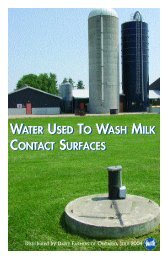Canadian Quality Milk On-Farm Food Safety Program - Centre ...
Canadian Quality Milk On-Farm Food Safety Program - Centre ...
Canadian Quality Milk On-Farm Food Safety Program - Centre ...
Create successful ePaper yourself
Turn your PDF publications into a flip-book with our unique Google optimized e-Paper software.
<strong>Canadian</strong> <strong>Quality</strong> <strong>Milk</strong><br />
- Allow animals back to the barn during very hot weather or provide a mister ⎯<br />
if artificial shade is provided, it should be built to allow for good air flow.<br />
- Design the grazing system to allow fields/paddocks with shaded areas to be<br />
rested when shade is not essential.<br />
Restrict cattle access to surface waters and other natural areas.<br />
• Check herd health records for environmental diseases.<br />
• Check natural areas for excessive erosion and compaction.<br />
• Consider permanent fencing and alternate watering devices for frequently used<br />
areas.<br />
• Consider temporary barriers (e.g., electric fencing, or controlled access) for less<br />
heavily used areas.<br />
Provide alternative watering devices.<br />
• Provide clean water supply from nearby or other water sources for heavily used<br />
areas.<br />
• Supply water using nose pumps, gravity-fed springs, solar pumps, or external<br />
power sources.<br />
• Inspect alternate water sources to ensure proper functioning and sanitation.<br />
• Use gravel or other wear-resistant surfaces near watering area to improve<br />
sanitation.<br />
• Use proper base and resilient surface materials to ensure adequate drainage<br />
around watering areas.<br />
1.3.2 Manure Storage and Handling<br />
Restrict cattle access to manure storage. Reduce the risk of disease<br />
transmission by preventing cattle access to the manure storage. Cattle must also be<br />
prevented from coming in contact with runoff from the manure storage or cattle<br />
yards. Microbes that are present in manure cause many diseases. The E.coli<br />
(Escherichia coli) organism, for example, commonly found in bedding and manure,<br />
can be transmitted if cows’ teats contact manure. This can lead to mastitis and other<br />
diseases, as well as contamination of the milk. Contamination of hides with manure<br />
also increases the risk of spreading E.Coli in the processing<br />
plant when cattle are slaughtered for meat<br />
Select an appropriate manure management system.<br />
Manure must be regularly removed from cattle housing and<br />
feeding facilities to prevent the spread of disease, maintain<br />
good health and keep cattle clean. The system should prevent<br />
cattle access to manure, reduce odour and fly infestation, and<br />
prevent the contamination of drinking water.<br />
Ensure adequate size for dairy manure storage. Manure<br />
storage facilities should be large enough to store manure,<br />
bedding, wasted feed and all liquids, including precipitation,<br />
A manure management<br />
system has two main<br />
components: equipment to<br />
collect and transfer manure;<br />
and a storage facility where<br />
manure is held when it<br />
cannot be spread.<br />
Check with your provincial<br />
or regional authority for the<br />
recommended or required<br />
storage.<br />
June 2010 1—9
















